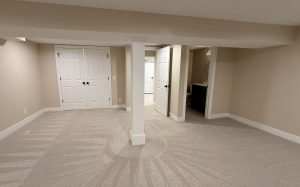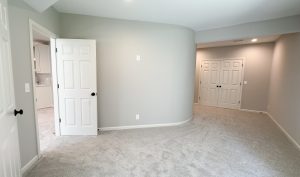When it comes to your basement remodel, doors can seem like one of the least important things to worry about. Floors, wet bars, walls, and ceiling beams often take precedent during the design process.
But doors can add a lot to the overall feel and function of a basement. Is this a place to throw parties in or a kids’ playroom? A man cave or home office? Your doors can create a fun, professional, or cozy atmosphere to your basement.
Barn doors can make a grand, rustic-chic statement while pocket doors can make a room feel sleek and sophisticated. Sometimes the doors you want don’t fit the space (or your budget). Luckily, there are plenty of options out there. Sometimes you have to take privacy into account. It’s an important decision, and there are three main things to consider: style, space, and materials.
Keep It Simple
The most common type of door is a simple traditional hollow core door, sometimes called a slab door. This is the same kind of door found throughout most houses on bedrooms, bathrooms, and closets. The style, whether flat or tray or grooved, doesn’t affect the price much. Even on high-end basement remodels, clients choose these types of doors so they can spend money on things like a linear fireplace, a wet bar, or home theater. Solid wooden doors sound nice in theory, but the visual payoff usually isn’t worth the extra money.
This doesn’t mean that standard doors have to be plain. You still have the opportunity to add whatever paint or finish you like.
Step Up to a Barn Door
Regular doors aren’t as fun as barn doors. And they don’t make much of a statement. Running along a metal track, wooden barn doors are large, heavy, and come in a wide variety of patterns and finishes, as well as sizes (see above photo). They can be stained or painted based on the level of rustic you’re looking for. In terms of size, we often install standard 36-inch doors, but we also do double barn doors. Woods like knotty alder contain the types of blemishes that give off a cabin feel.
At Empire Remodeling, we make our barn doors custom on site. You may see barn doors at Home Depot or Lowe’s at a fairly low price, but discount doors like these tend to warp. The custom build costs more, but the door will last a lot longer.
Besides the cost, the main drawback of barn doors is that they don’t seal. Because of this, we recommend them for entryways into areas like lounges or playrooms. They don’t provide the kind of privacy most people prefer with a bedroom. On the upside, their sliding design takes up less space because they don’t have to swing out.
The Versatile and Space Saving Pocket Door
Pocket doors are another space-saving option that usually cost less than half of what a barn door costs. These can be either stained or painted. Typically, they’re made from the same material as a standard hollow core door, but you can use high-end materials like framed glass or aluminum. People often use these to lead to a main living or spare bedroom. However, the design of these don’t allow for maximum privacy. Still, you’re going to get more soundproofing with this option than with a barn door.
Your Little Secret
One style that’s becoming more common is hidden bookcase doors. These typically go in the middle of the wall, and just like in an episode of Scooby Doo, you can’t tell there’s even a doorway there. These are usually painted and swing out on a hinge. Because of the highly-customized construction of these types of doors, the cost is fairly high. But it’s a hidden door, and how cool is that? These are great for special areas like game rooms or home theaters. Keep in mind this door moves, so you probably don’t want to put fragile items on the shelves.
If more than one of these options sounds appealing, you can mix it up. Use a standard door for a spare bedroom and a barn door for the game room. You get the idea.





